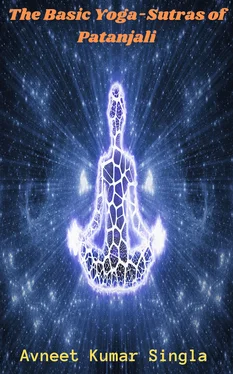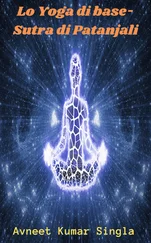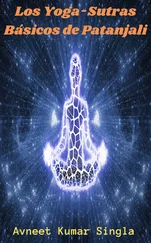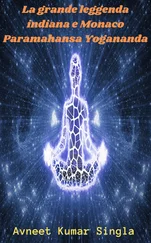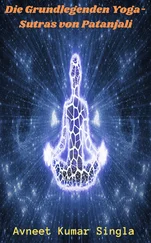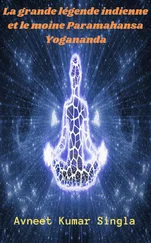The Basic Yoga-Sutras of Patanjali
Avneet Kumar Singla
Copyright © 2021-2040 by Avneet Kumar Singla
All rights reserved. No part of this publication may be reproduced, distributed, or transmitted in any form or by any means, including photocopying, recording, or other electronic or mechanical methods, without the prior written permission of the publisher, except in the case of brief quotations embodied in critical reviews and certain other non-commercial uses permitted by copyright law. For permission requests, write to the publisher, addressed “Attention: Permissions Coordinator,” at the address below.
Avneet Kumar Singla
avneetkumarsingla2@gmail.com
Disclaimer
All the Information Provided in this book is best to our knowledge and believe. However, we will not guarantee the Authenticity, Completeness and accuracy of the information.
Contents
INTRODUCTION TO BOOK 1
Book 1
INTRODUCTION TO BOOK 2
Book 2
INTRODUCTION TO BOOK 3
Book 3
INTRODUCTION TO BOOK 4
Book 4
The Yoga Sutras of Patanjali are in themselves extremely short, less than ten pages in size in the original. However, they contain the essence of practical wisdom, which is presented in admirable order and detail. The theme, if the present is right, is the Great Rebirth, The Birth of the spirit from the psychic man: the same theme that Paul so wisely and eloquently set forth to his disciples at Corinth, the theme of all mystics in all lands.
We see ourselves as a purely physical life, in these material bodies of ours. In reality, we are indeed far from the pure physical life; for ages our life has been psychic, we are cantered and immersed in the psychic nature. Some of the schools of India say that the psychic nature is, so to speak, a reflection in which the things seen by the physical eyes and heard by the physical ears are mirrored. But this is a magic mirror; the images remain and take on a certain life of their own. Thus, within the psychic realm of our lives, a pictured world grows up in which we dwell; a world of images of things seen and heard, and therefore a world of memories; a world also of hopes and desires, of fears and regrets. The spiritual life grows up among these images, which are based on a measurement and a comparison, on the mass of images combined into general ideas; on the abstraction of new concepts and images of these; until a new world is built from within, full of desires and hatred, ambition, envy, longing, speculation, curiosity, self-will, self-interest.
The teaching of the East is that all these are true forces superimposed by false desires; that, although in manifestation psychic, they are essentially spiritual; that the psychic man is the veil and prophecy of the spiritual man.
The purpose of life, therefore, is the realization of this prophecy; the revelation of the Immortal Man; the birth of the spiritual from the psychic, whereby we enter into our divine inheritance and inhabit eternity. This is indeed the Salvation, the purpose of all true religion at all times.
Patanjali has in mind the spiritual man who is to be born from the psychic. Its aim is to put in order the practical means of Revelation and regeneration and to indicate the fruit, glory and power of this new birth.
Through the Sutras of the first book, Patanjali is concerned with the first great problem, the emergence of the spiritual man from the veils and meshes of the psychic nature, the moods and attires of the mental and emotional people. Later, the contemplation of the nature and powers of the spiritual man will come as soon as he has freed himself from the psychic veils and trammels, and a look at the realms in which these new spiritual powers are to be revealed.
At this point a word of explanation may come. I was asked why I use the word Sutras, for these rules of Patanjali's system, when the word aphorism has been connected for a generation with them in our minds. The reason for this is as follows: the name aphorism, at least for me, indicates a splendid sentence of very general application; a piece of proverbial wisdom that can be quoted under many circumstances, and which will almost bear on its face the proof of its truth. But with a Sutra the case is different. It comes from the same root as the word "sewing" and in fact means a thread, which therefore indicates a close-meshed, successive chain of reasoning. Each Sutra not only has a certain place in the system, but will also be almost meaningless and by no means self-evident. So I thought best to stick to the original word. The Sutras of Patanjali are as closely connected, as interdependent, as the propositions of Euclid, and can no longer be taken out of their proper attitude.
In the second part of the first book, the problem of the origin of the spiritual man is further discussed. We are led to consider the obstacles to its emergence, to overcome the barriers and certain steps and stages of ascent from the ordinary consciousness of practical life to the finer, deeper, radiant consciousness of the spiritual man.
1. OM: here follows instruction in Union.
Union, here as always in the scriptures of India, means Union of the individual soul with the Oversoul; of the personal consciousness with the Divine Consciousness, whereby the mortal becomes immortal and enters into the eternal. Therefore, salvation is first freedom from sin and the sorrow that comes from sin, and then a divine and eternal well-being, whereby the soul participates in being, the wisdom and glory of God.
2. Union, spiritual consciousness, is gained through the control of the versatile psychic nature.
The goal is the full consciousness of the spiritual man, enlightened by the divine light. Nothing but the obdurate resistance of psychic nature holds us back from the goal. The psychic powers are spiritual forces that are wild, perverse and drawn from their proper channel. Therefore, our first task is to regain control of this perverse nature, to chastise, purify and restore the misplaced forces.
3. Then the seer comes in his real nature of consciousness.
Egotism is only the perversion of spiritual being. Ambition is the reversal of spiritual power. Passion is the distortion of love. The mortal is the limit of the immortal. When these false images make way for the true, then the spiritual man stands there shining, like the sun when the clouds disperse.
4. So far, the seer, was involved in the activities of the psychic nature.
The power and life that are the heritage of the spiritual man have been caught and entangled in psychic activities. Instead of being pure in the divine, there were dubious, combative ones. Selfishness, his hand against every man. Instead of the light of pure vision, there were restless senses that were new and imaginative. Instead of spiritual joy, the undivided joy of Being Pure, there was indulgence of body and mind. They are all real forces, but distorted by their true nature and goal. They must be eradicated like gems from The matrix, like the core from the reeds, steadily and without destructive force. Spiritual forces should be pulled out of the psychic meshes.
5. The psychic activities are five; they are either subject or not subject to the five hindrances (book II, 3).
Psychic nature is built up by the power of image-making, the power that lies behind it and dwells in thought Images. These images do not remain silent in the mind; they are kinetic, restless, stimulating to new acts. Thus the thought image of pleasure suggests and invites a new enjoyment; the image of past joy is framed in regrets or hopes. And there is the incessant play of the desire to know, to penetrate into the essence of things, to classify. This also deals incessantly with the thought Images. So that we can classify the activities of psychic nature in this way:
Читать дальше
